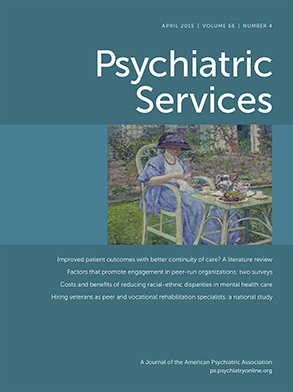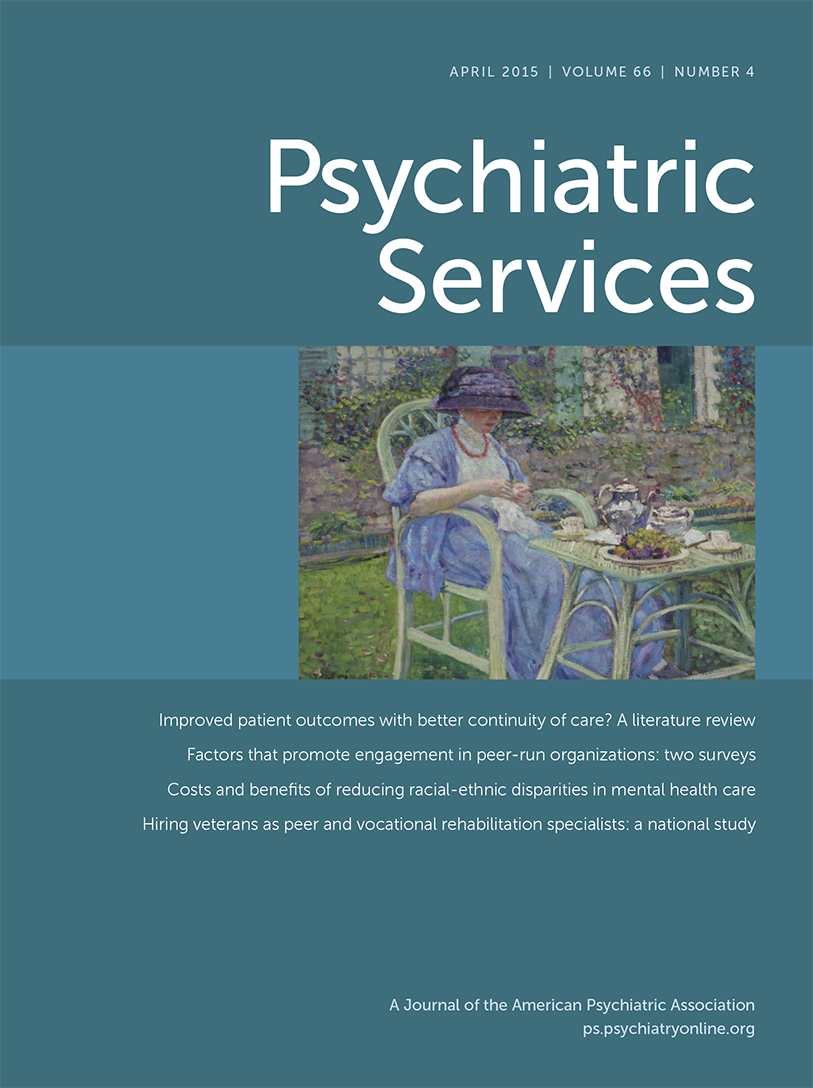States continue to struggle to sustain their Medicaid programs against a background of rising enrollment and austerity budgets. Mental health care accounts for nearly 10% of Medicaid spending, and schizophrenia care alone accounts for about 1.5%−3%, which makes schizophrenia a logical target for realizing savings through better disease management interventions (
1). Schizophrenia is costly to states in other ways as well. Persons with schizophrenia interact with the criminal justice system at a higher rate than the rest of the population. A recent study found that 46% of patients with schizophrenia had at least one interaction with the justice system as either a perpetrator or a victim of a crime in the year covered by the study (
2). The associated costs to the states of these interactions are substantial, as evidenced by an average annual cost of $1,881 per person (in 2013 dollars), which includes only the cost of arresting and incarcerating the perpetrators but not the cost of providing forensic inpatient care (
2).
Antipsychotic medications are effective in controlling disturbing symptoms of schizophrenia, including hallucinations and paranoid delusions, and adequate adherence has been shown to reduce the risk of hospitalization, the costliest form of health care. At the same time, adherence to antipsychotic medications is known to be poor; a literature review found an average rate of adherence of 50% (
3). Poorer adherence is associated with poorer outcomes and higher costs (
3); conversely, interventions that increase adherence to antipsychotic medications have been shown to improve outcomes and reduce costs (
4–
6).
However, improving adherence comes at a cost to states in the form of higher spending on prescription drugs and other interventions. To our knowledge, an analysis to estimate the potential net savings to states from improving adherence to antipsychotic medications among patients with schizophrenia has not been conducted. Therefore, in this analysis, our objectives were to quantify these potential savings and provide guidance for states on investment priorities.
Cost Model and Findings
We conducted a literature review to examine schizophrenia-related costs incurred by states, including direct costs for mental health care to Medicaid programs in various categories (inpatient, outpatient, and prescription drugs), and criminal justice system costs in various categories (prosecution, incarceration, and forensic psychiatric evaluation and treatment). Our main data source was a study in which the authors calculated schizophrenia-related costs incurred by various state agencies in Connecticut over a two-year period, detailing spending in the categories previously mentioned (
7). Spending varied based on whether a person with schizophrenia was involved with the justice system ($48,980 over two years) or not involved with the justice system ($24,728 over two years) (
7). We used linear equations to estimate costs to other states on the basis of each state’s population and per capita mental health spending. We then validated model estimates against peer-reviewed published studies of the costs of schizophrenia in the United States. Finally, we used existing published data on the relationship between antipsychotic adherence and costs to estimate savings that states might realize by promoting antipsychotic adherence.
Our model estimated annual schizophrenia-related spending of $21.4 billion (in 2013 dollars) by Medicaid programs and other state agencies. Most of these costs are direct health care costs ($16.9 billion, or 79%), with the remaining $4.6 billion related to criminal justice system spending. We estimated that approximately 43.5% of the health care costs stem from psychiatric outpatient treatment, 40.7% from inpatient treatment, and 15.2% from prescription drugs. Annual costs per state range from $33.1 million in Idaho to $3.29 billion in California.
On the basis of empirical evidence of the effects of increased antipsychotic adherence on various outcomes, we estimated that better adherence could yield annual net savings of up to $3.28 billion to states. Most of these savings would come from lower hospitalization rates (68.0% of savings, or $2.54 billion), although lower costs of outpatient care and lower rates of criminal justice system involvement would account for 13.8% ($514 million) and 18.3% ($684 million) of the total, respectively. Spending on prescription drugs would increase by about 18.3% ($462 million). On a per patient basis, states could achieve net savings of $1,580 per patient per year.
Discussion
Research has shown that several interventions improve antipsychotic adherence among persons with schizophrenia (
4–
6). Some of these studies have also provided direct evidence of the cost-effectiveness of these interventions. A recent study of patients with schizophrenia in the United Kingdom demonstrated that even small financial incentives (less than $25 per patient per month) increased adherence to antipsychotic medications from a baseline of 69% to 85% (
6). The yearly cost of $300 per patient accounted for only about one-fifth of the potential savings from increased adherence, because patients were paid only when they took their medication, making incentives a potentially cost-effective intervention for states.
Replacing traditional oral therapy with long-acting injectable (LAI) antipsychotics has been shown to increase adherence (
4). Data from the Medicaid State Drug Utilization file show that the average annual cost of LAI antipsychotics ranges from $340 per patient for the generic haloperidol decanoate to $1,395 to $10,720 for branded LAI antipsychotics. These drug costs are greater than the costs of oral medications ($5 annually for generic haloperidol and $143 to $207 for branded oral antipsychotics). Thus using generic LAI antipsychotics could save more than $1,000 per patient per year. Conversely, use of branded LAI antipsychotics would lead to net savings only for patients with above-average risk and for states with high average per capita spending on schizophrenia care.
Medication management programs, such as counseling by pharmacists or advanced practice nurses, are another potential method for increasing adherence. Two specific medication management programs—cognitive adaptive training, which attempts to change patients’ behavior by modifying their home environment through use of signs, alarms, and checklists, and electronic medication monitoring, a computerized system that reminds patients to take their medications and tracks adherence—have also been shown to increase adherence to antipsychotics among patients with schizophrenia to 92%, compared with 73% adherence in the group that received treatment as usual (
5). With reported costs of $1,560 and $2,160 per patient per year, respectively, the two interventions would be cost saving only for higher-risk patients or in states with high per capita spending (
5).
Limitations
The estimates have several key limitations. Cost data were derived from one, densely populated state, and estimates of savings were derived from studies conducted across the United States. In addition, the populations in the cited adherence intervention studies range from 141 to just over 3,000 patients. Thus further research is needed to determine whether results can be scaled up to the state level.
Conclusions
Our findings suggest that states can generate substantial savings by improving adherence to antipsychotic drugs among persons with schizophrenia by using evidence-based approaches properly matched to patient risk. Although the financial gains may not be seen immediately upon implementation of an adherence improvement program, there is a clear business case for states to invest in interventions such as financial incentives, increased use of LAI antipsychotics, and medication management programs. In addition to financial benefits, much human suffering can be avoided through better management of this devastating illness. Nonfinancial benefits from smart investments aimed at improving antipsychotic adherence will be accrued by the affected individuals and their loved ones—and also by the larger public, because in addition to increased rates of criminal justice system involvement among patients with untreated schizophrenia, the disease can drive people to rare yet extremely serious acts of violence.

